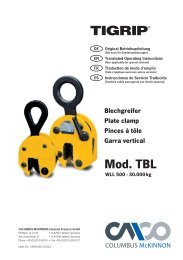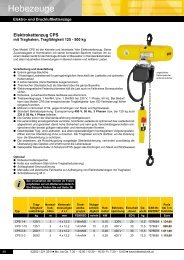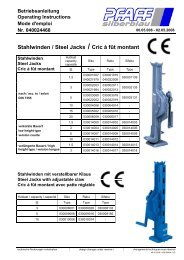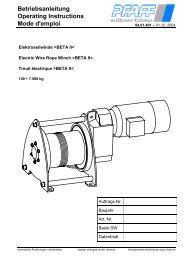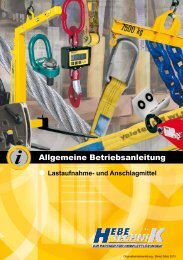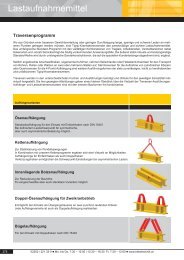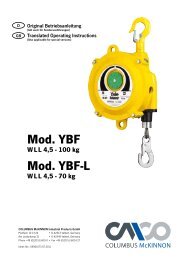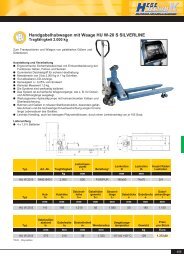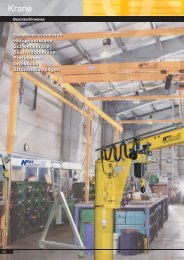Yalelift 360 ATEX - Carl Stahl
Yalelift 360 ATEX - Carl Stahl
Yalelift 360 ATEX - Carl Stahl
- Keine Tags gefunden...
Sie wollen auch ein ePaper? Erhöhen Sie die Reichweite Ihrer Titel.
YUMPU macht aus Druck-PDFs automatisch weboptimierte ePaper, die Google liebt.
cast iron against aluminium, magnesium orpertinent alloys. This applies especially in caseof rust or surface rust. Chain and load hook inparticular can generate rust (surface rust) atthe wear points. To ensure correct operationof the product, these wear points must beclear from rust and – in the application area atpossible friction, impact or grinding points - donot present material combinations from a.m.aluminium alloy and steel (exception: antiruststeel), in order to exclude spark formation asa result of mechanical impact.Hand and load chainAlways ensure that hand and load chain aswell as the load are guided to exclude grindingor sliding contact with external constructionsor components. Depending on the degree ofcorrosion, the conductive discharge capabilityof load and hand chains can worsen to aneffect that it is not adequate any longer. Thisimplies that rusty hand and load chains mustnot be further used.Attention: The user has to operate the unit toavoid sparking from either hand or load chain.Models YLITP/G, YLLH and Towerlift must beoperated from below.For additional safety and to avoid sparking byimpact or friction during operation, the unitsare equipped with stainless steel hand chains.Top and load hooks are copper plated.Trolleys are provided with solid bronze wheelsand buffers.Option: Stainless steel load on request.Attachment pointsAttachment points have to be selected to ensurethat the expected forces can be safely accepted.The unit must move freely under loadin order to avoid incorrect additional loading.STATIC ELECTRICITYIn order to avoid static charge at plastic parts,do not use parts of attachment (e.g. roundslings) in the area of facing panels, hand chainguide and cap (see Fig. 11).When cleaning these components, make sureto apply only materials which do not allowelectrostatic charging.TRANSPORT AND STORAGESafe transportDuring transport of the unit observe tofollowing:- Do not throw the hoist down. Alwaysplace it properly on the ground.- Hand and load chains must be transportedin a way to avoid knotting andformation of loops.INITIAL OPERATIONInspection prior to initial operationHoists including carrying construction haveto be inspected prior to initial operation andafter each essential alteration by a competentperson*. The inspection shall establish that theunit is safe and ready for operation.*A competent person is a person with professionaltraining, experience and actual operationto provide the necessary expertise for theinspection of material handling equipment.Check brake functionPrior to each operation check brake functionas follows:- Lift the load over a short distance and loweragain. When releasing the hand chain, theload must be safely held in any position.Attention: In case of brake failure consult themanufacturer/supplier!CORRECT OPERATIONThe unit is designed for lifting, lowering, pullingand spanning of loads.- The capacity indicated on the product is themaximum safe working load (WLL) that maybe attached.- The load and suspension hook of the hoistduring lifting operations must be perpendicularto the centre of the load in order toprevent swinging during lifting (Fig. 1).- Do not allow personnel to stay or pass undera suspended load.- After lifting or tensioning, a load must not beleft unattended for a longer period of time.- Start moving the load only after it has beenattached correctly and all personnel are clearof the danger zone.- The operator must ensure that the load isattached in a manner that does not exposehimself or other personnel to danger by thehoist, chain(s) or the load.- The hoists can be operated in ambienttemperatures between -10°C and +40°C.Consult the manufacturer in case of extremeworking conditions.Note: At ambient temperatures below 0°Cthe brake should be checked for freezing.- The air gap between trolley side plate andcarrying beam must be 2 - 3 mm in order toavoid a potential source of ignition.- In case of operational turning of loads asstandard, the bottom blocks have to beprovided with swivel hooks supported byaxial bearings. In case of queries consultthe manufacturer.- Trolleys should be generally provided withbuffers in order to exclude a possible sourceof ignition.6- In order to ensure correct operation ofmanual hoists, not only the operating instructions,but also the accident preventionact valid for the country and area where theproduct is used, have to be adhered to.- Maintenance jobs as well as the annualinspection may carried out in Ex free areasonly.- In case of functional defects stop using thehoist immediately.- Trolleys must be operated on horizontalcarrying beams only. Operation on slopedbeams is not permitted.- The units must not be operated in aggressiveatmospheres.INCORRECT OPERATION(Examples)- Do not exceed the rated capacity of the hoistor the carrying construction.- Do not lift stuck or jammed loads.- Welding on hook and load chain is strictlyforbidden. The load chain must never beused as ground connection during welding(Fig. 2).- Avoid side pull, i.e. side load on either housingor bottom block (Fig. 3).- The load chain must not be used for lashingpurposes (sling chain) (Fig. 4).- It is forbidden to use this product for thetransportation of people (Fig. 5).- Do not knot or shorten the load chain byusing bolts/screws/screw drivers or otherdevices (Fig. 6).- Do not repair load chains which are firmlyinstalled in hoists.- Do not remove the safety latch from the topor bottom hooks (Fig. 7).- Never attach the load on the top of the hook(Fig. 8).- Do not use the chain end stop (Fig. 11) asan operational limit device.- Do not throw the hoist down. Always placeit properly on the ground.- The longitudinal downward slope of thecarriageway must not exceed 0,3 %.- The adjustment of the trolley width must notbe extended in order to e.g. obtain a smallerradius curvature.- Any modifications of the hoist or trolley areprohibited.- Load can not fall into the loose chain - riskof chain break!- Turning of loads under normal operatingconditions is not allowed. (Optional additionalequipment should be requested fromthe manufacturer.- Never attach more than one load liftingattachment to the load hook of the hoist ortrolley.



